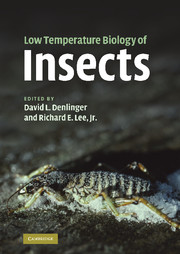Book contents
- Frontmatter
- Contents
- List of contributors
- Preface
- PART I PHYSIOLOGICAL AND MOLECULAR RESPONSES
- PART II ECOLOGICAL AND EVOLUTIONARY RESPONSES
- 8 The macrophysiology of insect cold-hardiness
- 9 Evolutionary physiology of insect thermal adaptation to cold environments
- 10 Insects at not so low temperature: Climate change in the temperate zone and its biotic consequences
- 11 Genetic variability and evolution of cold-tolerance
- 12 Life-history adaptations to polar and alpine environments
- PART III PRACTICAL APPLICATIONS
- Index
- References
11 - Genetic variability and evolution of cold-tolerance
from PART II - ECOLOGICAL AND EVOLUTIONARY RESPONSES
Published online by Cambridge University Press: 04 May 2010
- Frontmatter
- Contents
- List of contributors
- Preface
- PART I PHYSIOLOGICAL AND MOLECULAR RESPONSES
- PART II ECOLOGICAL AND EVOLUTIONARY RESPONSES
- 8 The macrophysiology of insect cold-hardiness
- 9 Evolutionary physiology of insect thermal adaptation to cold environments
- 10 Insects at not so low temperature: Climate change in the temperate zone and its biotic consequences
- 11 Genetic variability and evolution of cold-tolerance
- 12 Life-history adaptations to polar and alpine environments
- PART III PRACTICAL APPLICATIONS
- Index
- References
Summary
Introduction
Temperature has a large impact on the distribution and abundance of insect species. This can be seen in the varying degrees of behavioral, physiological, or biochemical adaptations to endure exposure to seasonal and acute thermal fluctuations. Variance in thermal tolerance limits between species and/or individuals is also highly influenced by acclimation/acclimatization effects and the underlying genetic variability for these traits (Ayrinhac et al., 2004; Hoffmann et al., 2005a). Thus, cold-tolerance is constrained by the underlying genetic background, including genetic correlations among traits, but also by various factors, such as the thermal history of the individual (acclimation), life stage, age, light cycle and diapause. The contributions of genetic and environmental factors to a trait such as cold-tolerance are difficult to separate if the appropriate design and methods are not used, and this is highlighted by the ongoing discussion of the relative importance of genetic variation versus phenotypic plasticity for thermal adaptation (Gienapp et al., 2008). Ayrinhac et al. (2004) and Hoffmann et al. (2005a) both found genetic variation in cold-tolerance of Drosophila melanogaster, but they also found that the contribution to cold-tolerance of acclimation was greater than the contribution of genetic variation between both species and populations within species. Differences in cold-tolerance between and within insect species therefore may relate more to factors in the surrounding environment than to differences in the genetic background.
- Type
- Chapter
- Information
- Low Temperature Biology of Insects , pp. 276 - 296Publisher: Cambridge University PressPrint publication year: 2010
References
- 6
- Cited by



